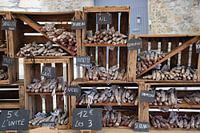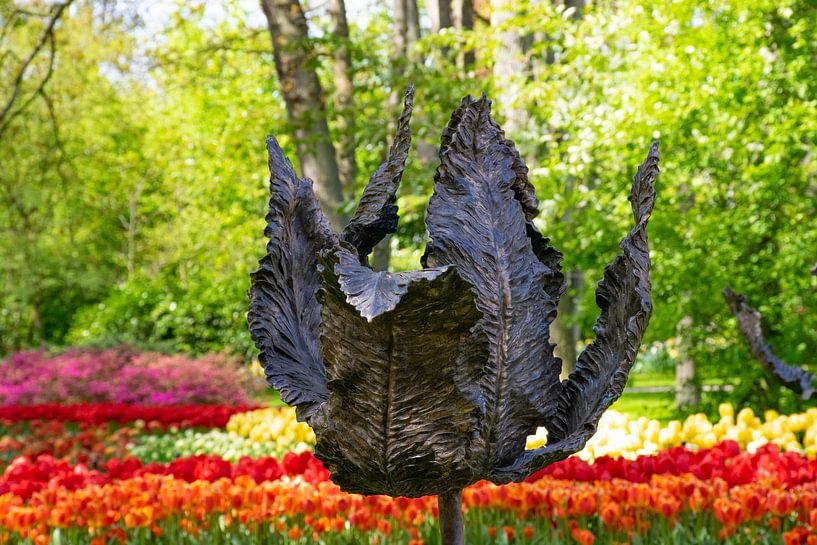Buy this flower art Black Tulip by Ingrid de Vos - Boom on canvas, ArtFrame, poster and wallpaper, printed on demand in high quality.
About "Black Tulip"
by Ingrid de Vos - Boom
About the artwork
"To have discovered the black tulip, to have seen it for a moment, then to lose it, to lose it forever," this is a quote from the 1865 historical novella The Black Tulip by Alexandre Dumas.
The "tulip mania" in the Netherlands , which this book is about and this artwork was inspired by, was a period of speculation and madness surrounding the trade in tulip bulbs in the 1630s. At the time, tulips were a relatively new and exotic crop in Europe and were considered very precious. They were a symbol of wealth and status and were considered a luxury item. The trade in tulip bulbs began in the late 16th century and became increasingly popular in the following decades. In the 1630s, the demand for tulip bulbs peaked and the price of bulbs began to rise exponentially. Some bulbs sold for thousands of guilders, which was equivalent to the annual income of an average citizen. The craziness surrounding the tulip trade peaked in the winter of 1636-1637, when tulip bulb prices were at an all-time high and people all over the country invested in the trade.
In February 1637, the market collapsed and the price of tulip bulbs fell dramatically.
This beautiful sculpture, made of Corten steel, is 1 of a set of 2, which you will find at Keukenhof. Surrounded by the most beautiful tulips in all colours of the rainbow, this black tulip stands there and stands out above the others I took this picture on a bright day in early May 2023. It was one of the few really beautiful and sunny days this spring and what a treat it is to be in this beautifully landscaped park.

About Ingrid de Vos - Boom
As the daughter of a photographer, photography has been a big part of my life. I love nature and especially flowers, so you see this most in my work. I have worked as an independent make-up artist for over 15 years, developing my eye for detail. Composition.. Read more…
 Germany
Germany Ordered in February 2022
Ordered in February 2022
 Germany
Germany Ordered in May 2023
Ordered in May 2023
 Netherlands
Netherlands Ordered in August 2018
Ordered in August 2018
 Netherlands
Netherlands Ordered in July 2021
Ordered in July 2021
 Germany
Germany Ordered in September 2022
Ordered in September 2022
 Netherlands
Netherlands Ordered in April 2021
Ordered in April 2021
 Germany
Germany Ordered in April 2021
Ordered in April 2021
 Germany
Germany Ordered in April 2020
Ordered in April 2020
 Germany
Germany Ordered in July 2020
Ordered in July 2020
 Germany
Germany Ordered in January 2021
Ordered in January 2021
 Germany
Germany Ordered in November 2020
Ordered in November 2020
 Netherlands
Netherlands Ordered in February 2023
Ordered in February 2023
About the material
ArtFrame™
Interchangeable Art Prints
- High-quality print
- Easily interchangeable
- Acoustic function
- Large sizes available
Discover the artworks of Ingrid de Vos - Boom
 Paris Place DauphineIngrid de Vos - Boom
Paris Place DauphineIngrid de Vos - Boom WinterglowIngrid de Vos - Boom
WinterglowIngrid de Vos - Boom DewIngrid de Vos - Boom
DewIngrid de Vos - Boom Spring has sprungIngrid de Vos - Boom
Spring has sprungIngrid de Vos - Boom Blue ShuttersIngrid de Vos - Boom
Blue ShuttersIngrid de Vos - Boom Pollard willows in the snowIngrid de Vos - Boom
Pollard willows in the snowIngrid de Vos - Boom Follow the sunIngrid de Vos - Boom
Follow the sunIngrid de Vos - Boom Tulips KeukenhofIngrid de Vos - Boom
Tulips KeukenhofIngrid de Vos - Boom Park the PlantationIngrid de Vos - Boom
Park the PlantationIngrid de Vos - Boom Spring in the orchardIngrid de Vos - Boom
Spring in the orchardIngrid de Vos - Boom Ladybird between the blue grapesIngrid de Vos - Boom
Ladybird between the blue grapesIngrid de Vos - Boom Sunrise at the Lek RiverIngrid de Vos - Boom
Sunrise at the Lek RiverIngrid de Vos - Boom Magic MorningIngrid de Vos - Boom
Magic MorningIngrid de Vos - Boom Abstract NatureIngrid de Vos - Boom
Abstract NatureIngrid de Vos - Boom Dutch Tulips: the colourful KeukenhofIngrid de Vos - Boom
Dutch Tulips: the colourful KeukenhofIngrid de Vos - Boom Tidal art: Wooden Poles on the Coast of Saint-MaloIngrid de Vos - Boom
Tidal art: Wooden Poles on the Coast of Saint-MaloIngrid de Vos - Boom TideTales - the surf at DomburgIngrid de Vos - Boom
TideTales - the surf at DomburgIngrid de Vos - Boom Here on the CoastIngrid de Vos - Boom
Here on the CoastIngrid de Vos - Boom French MarketIngrid de Vos - Boom
French MarketIngrid de Vos - Boom Sun in your PalmIngrid de Vos - Boom
Sun in your PalmIngrid de Vos - Boom













 Flowers
Flowers Joyful Moments
Joyful Moments Kitchen court
Kitchen court Nature photography
Nature photography Photo wallpaper
Photo wallpaper Photography
Photography Plants
Plants Spring
Spring Tulip
Tulip Vibrant Colors
Vibrant Colors









